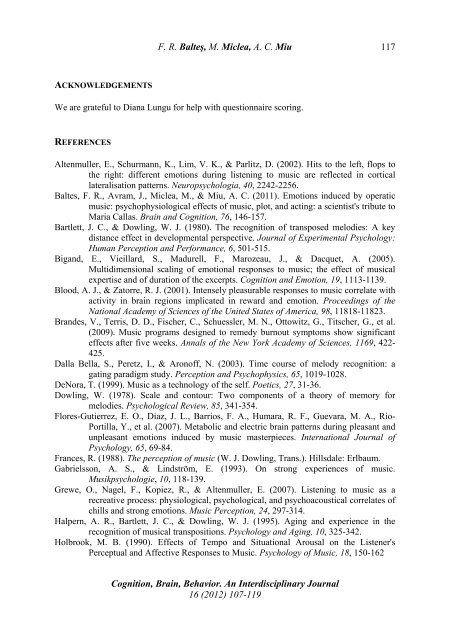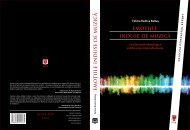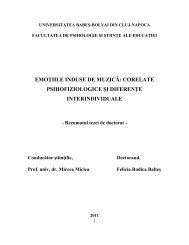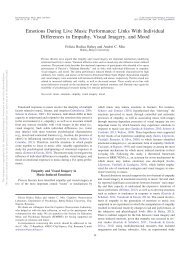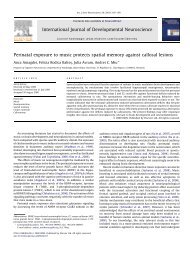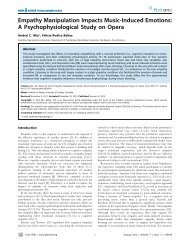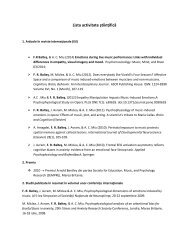o_19k6fnuqsqg41mt7rqp1c8pkueo.pdf
Create successful ePaper yourself
Turn your PDF publications into a flip-book with our unique Google optimized e-Paper software.
F. R. Balteş, M. Miclea, A. C. Miu<br />
117<br />
ACKNOWLEDGEMENTS<br />
We are grateful to Diana Lungu for help with questionnaire scoring.<br />
REFERENCES<br />
Altenmuller, E., Schurmann, K., Lim, V. K., & Parlitz, D. (2002). Hits to the left, flops to<br />
the right: different emotions during listening to music are reflected in cortical<br />
lateralisation patterns. Neuropsychologia, 40, 2242-2256.<br />
Baltes, F. R., Avram, J., Miclea, M., & Miu, A. C. (2011). Emotions induced by operatic<br />
music: psychophysiological effects of music, plot, and acting: a scientist's tribute to<br />
Maria Callas. Brain and Cognition, 76, 146-157.<br />
Bartlett, J. C., & Dowling, W. J. (1980). The recognition of transposed melodies: A key<br />
distance effect in developmental perspective. Journal of Experimental Psychology:<br />
Human Perception and Performance, 6, 501-515.<br />
Bigand, E., Vieillard, S., Madurell, F., Marozeau, J., & Dacquet, A. (2005).<br />
Multidimensional scaling of emotional responses to music; the effect of musical<br />
expertise and of duration of the excerpts. Cognition and Emotion, 19, 1113-1139.<br />
Blood, A. J., & Zatorre, R. J. (2001). Intensely pleasurable responses to music correlate with<br />
activity in brain regions implicated in reward and emotion. Proceedings of the<br />
National Academy of Sciences of the United States of America, 98, 11818-11823.<br />
Brandes, V., Terris, D. D., Fischer, C., Schuessler, M. N., Ottowitz, G., Titscher, G., et al.<br />
(2009). Music programs designed to remedy burnout symptoms show significant<br />
effects after five weeks. Annals of the New York Academy of Sciences, 1169, 422-<br />
425.<br />
Dalla Bella, S., Peretz, I., & Aronoff, N. (2003). Time course of melody recognition: a<br />
gating paradigm study. Perception and Psychophysics, 65, 1019-1028.<br />
DeNora, T. (1999). Music as a technology of the self. Poetics, 27, 31-36.<br />
Dowling, W. (1978). Scale and contour: Two components of a theory of memory for<br />
melodies. Psychological Review, 85, 341-354.<br />
Flores-Gutierrez, E. O., Diaz, J. L., Barrios, F. A., Humara, R. F., Guevara, M. A., Rio-<br />
Portilla, Y., et al. (2007). Metabolic and electric brain patterns during pleasant and<br />
unpleasant emotions induced by music masterpieces. International Journal of<br />
Psychology, 65, 69-84.<br />
Frances, R. (1988). The perception of music (W. J. Dowling, Trans.). Hillsdale: Erlbaum.<br />
Gabrielsson, A. S., & Lindström, E. (1993). On strong experiences of music.<br />
Musikpsychologie, 10, 118-139.<br />
Grewe, O., Nagel, F., Kopiez, R., & Altenmuller, E. (2007). Listening to music as a<br />
recreative process: physiological, psychological, and psychoacoustical correlates of<br />
chills and strong emotions. Music Perception, 24, 297-314.<br />
Halpern, A. R., Bartlett, J. C., & Dowling, W. J. (1995). Aging and experience in the<br />
recognition of musical transpositions. Psychology and Aging, 10, 325-342.<br />
Holbrook, M. B. (1990). Effects of Tempo and Situational Arousal on the Listener's<br />
Perceptual and Affective Responses to Music. Psychology of Music, 18, 150-162<br />
Cognition, Brain, Behavior. An Interdisciplinary Journal<br />
16 (2012) 107-119


